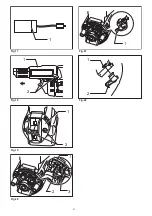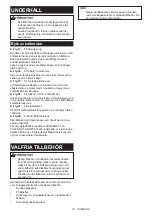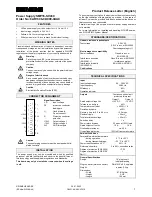
7 ENGLISH
FUNCTIONAL
DESCRIPTION
CAUTION:
•
Always be sure that the tool is switched off and
the battery cartridge is removed before adjust
-
ing or checking function on the tool.
Installing or removing battery
cartridge
►
Fig.1:
1.
Red indicator
2.
Button
3.
Battery cartridge
CAUTION:
•
Always switch off the tool before installing or
removing of the battery cartridge.
•
Hold the tool and the battery cartridge firmly when
installing or removing battery cartridge.
Failure to
hold the tool and the battery cartridge firmly may cause
them to slip off your hands and result in damage to the
tool and battery cartridge and a personal injury.
To remove the battery cartridge, slide it from the tool
while sliding the button on the front of the cartridge.
To install the battery cartridge, align the tongue on the
battery cartridge with the groove in the housing and slip
it into place. Insert it all the way until it locks in place
with a little click. If you can see the red indicator on the
upper side of the button, it is not locked completely.
CAUTION:
•
Always install the battery cartridge fully until the
red indicator cannot be seen. If not, it may acci
-
dentally fall out of the tool, causing injury to you
or someone around you.
•
Do not install the battery cartridge forcibly. If the
cartridge does not slide in easily, it is not being
inserted correctly.
Battery protection system (Lithium-
ion battery with star marking)
►
Fig.2:
1.
Star marking
Lithium-ion batteries with a star marking are equipped
with a protection system. This system automatically
cuts off power to the tool to extend battery life.
The tool will automatically stop during operation if the tool and/
or battery are placed under one of the following conditions:
•
Overloaded:
The tool is operated in a manner that causes
it to draw an abnormally high current.
In this situation, release the trigger switch on
the tool and stop the application that caused
the tool to become overloaded. Then pull the
trigger switch again to restart.
If the tool does not start, the battery is over
-
heated. In this situation, let the battery cool
before pulling the trigger switch again.
•
Low battery voltage:
The remaining battery capacity is too low
and the tool will not operate. In this situation,
remove and recharge the battery.
Indicating the remaining battery
capacity
Only for battery cartridges with the indicator
►
Fig.3:
1.
Indicator lamps
2.
Check button
Press the check button on the battery cartridge to indi
-
cate the remaining battery capacity. The indicator lamps
light up for a few seconds.
Indicator lamps
Remaining
capacity
Lighted
Off
Blinking
75% to 100%
50% to 75%
25% to 50%
0% to 25%
Charge the
battery.
The battery
may have
malfunctioned.
NOTE:
Depending on the conditions of use and the
ambient temperature, the indication may differ slightly
from the actual capacity.
Setting for desired screw length
►
Fig.4:
1.
Lever
2.
Stopper base
3.
Plate
4.
Casing
There are 3 positive-lock screw length settings. To
obtain the desired setting, pull out the stopper base
while depressing the lever until you see the number of
the desired screw length (indicated on the plate) appear
to rest on the very top edge of the casing.
See the table below for the relation between the number
indicated on the plate and the respective screw length
ranges.
Number indicated on the plate
Screw length range (mm)
25/28
25 - 28
32
28 - 35
40
35 - 41
Adjusting the driving depth
Depress the stopper base as far as it will go. While
keeping it in this position, turn the adjusting knob until
the bit tip projects approx. 5 mm from the stopper base.
Drive a trial screw. If the screw head projects above the
driving surface, turn the adjusting knob in the A direc
-
tion; if the screw head is countersunk, turn the adjusting
knob in the B direction.
►
Fig.5:
1.
Stopper base
2.
Casing
3.
Adjusting knob








































